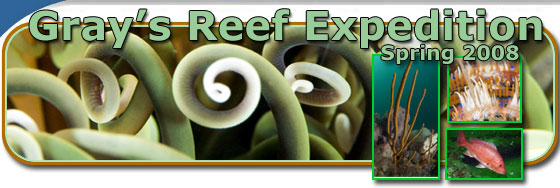Error processing SSI file
|
Mission Log: May 6, 2008
NOAA Ship Nancy Foster
By Dave Grenda
REEF
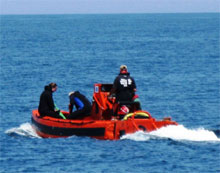 |
|
Divers departing Nancy Foster for their afternoon dive. (Photo: Venetia Butler)
|
Multibeam, multibeam, multibeam. That’s the mantra for today. All of last night through all of today, the ship is sailing a north-south oriented grid pattern collecting multibeam data of the sea bottom. It’s a slow, methodical process, and it’s the essence of research. The seas are still fairly calm but clouds have moved in with some occasional showers. Not as pleasant as yesterday, but still a great day on the Nancy Foster.
One of the first things you learn on a research trip is to be flexible. Regardless of what you plan to accomplish in the field, it will probably end up differently once you’re there. Often you have to modify your plans due to weather, equipment malfunctions, new discoveries, etc. Meeting these challenges can actually be one of the attractions to field research.
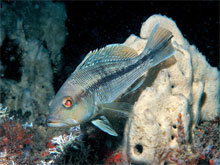 |
|
Black sea bass (Centropristus striatus)
|
One such “challenge” occurred for this cruise when we received notification that all NOAA diving operations would cease until Friday morning in order to review dive procedures and implement new diving rules. The goal is to make an already safe diving program even safer. Unfortunately that means no diving will be accomplished Tuesday (today), Wednesday, and Thursday. For some science trips, that could halt all research, but we’re fortunate in that there isn’t just one form of research being conducted on this trip. So while diving is taking a break, we’re still actively collecting multibeam data. As the dive gear dries, I’ll have a chance to learn what the other scientists are doing (and helping out where I can). Life is easier if you embrace the changes and not dwell on the downside.
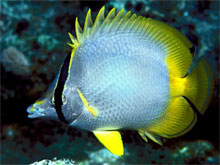 |
|
Spotfin butterfly fish (Chaetodon ocellatus)
|
Since my perspective is oriented towards diving, I’ll delve into yesterday’s dive. The waters in Gray’s Reef are transitioning from winter to summer. The temperatures are in the upper 60s to lower 70s, depending on how the water is mixing at any particular moment. I’m a little thin blooded so I wore a full wetsuit with a hood to keep my 98.6 degrees body temperature intact. We had numerous stinging sea jellies swimming around from the surface to 20’, so the full wetsuit provided welcome protection from any chance encounter with them. We used a handheld GPS receiver to locate the dive site – we’re much too far from any landmarks to gauge our position visually – and dropped a weighted dive buoy to mark the spot. With a simultaneous back-roll off the side of the small orange dive tender, we headed down the buoy line. Although sometimes the visibility can reach over 70’, we had a more typical 30’ visibility for that dive – sometimes visibility can be as bad as a few feet.
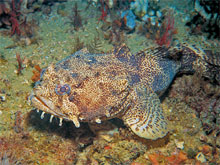 |
|
Oyster toadfish (Opsanus tau)
|
Most dive sites in and around Grays’ Reef consist of low profile ledges with numerous sponges, soft corals, and even some hard corals. Varying amounts of sand surrounds the ledges. These ledges act as magnets for fish and invertebrate sea life – it’s their home and grocery store. Because of the unique location of Gray’s Reef, it serves as a cross-roads for fish from the warm tropics farther south and from the temperate fish from farther north. We saw the year-round residents like porgies, seabass, snapper, and grouper but also the warm seasonal visitors like butterflyfish and damselfish. We even saw some of the more cryptic animals, the ones that tend to hide, like toadfish and eels. I counted 22 fish species in all - with some very large individual snapper and grouper. Because of our 65’ depth, we had to surface sooner than we had preferred – the deeper you dive, the quicker you run through your air supply.
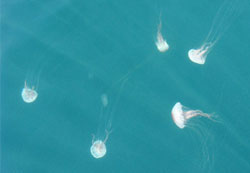 |
|
Sea nettle jelly (Chrysaora quinquecirrha ) were common down to about twenty feet during the dive. (Photo: Venetia Butler)
|
At 30 minutes into the dive we sent up a dive marker attached to a reel and slowly made our way back to the surface. Once we returned to the Nancy Foster and stowed dive gear, I went online. The ship has Internet access at sea (way cool). It took a couple minutes to submit my underwater fish survey information to www.reef.org so that others (scientists, decision makers, and even other divers) can track fish populations. Unfortunately I won’t be able to enjoy the waters of Gray’s Reef for a while, but I’ll be learning about the other research aboard the Nancy Foster and helping out where I can. |

